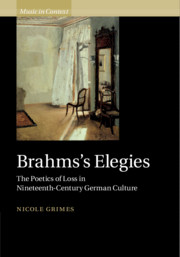Book contents
- Brahms’s Elegies
- Music in Context
- Brahms’s Elegies
- Copyright page
- Dedication
- Contents
- Figures
- Music Examples
- Tables
- Acknowledgements
- Introduction
- 1 Brahms’s Ascending Circle: Hölderlin and Schicksalslied
- 2 The Ennoblement of Mourning: Nänie and the Death of Beauty
- 3 A Disembodied Head for Mythic Justice: Gesang der Parzen
- 4 The Last Great Cultural Harvest: Nietzsche and the Vier ernste Gesänge
- 5 The Sense of an Ending: Music’s Return to the Land of Childhood
- Epilogue
- Appendix Translation of Theodor Adorno, ‘Brahms aktuell’ (1934)1
- Bibliography
- Index
- References
Bibliography
Published online by Cambridge University Press: 12 February 2019
- Brahms’s Elegies
- Music in Context
- Brahms’s Elegies
- Copyright page
- Dedication
- Contents
- Figures
- Music Examples
- Tables
- Acknowledgements
- Introduction
- 1 Brahms’s Ascending Circle: Hölderlin and Schicksalslied
- 2 The Ennoblement of Mourning: Nänie and the Death of Beauty
- 3 A Disembodied Head for Mythic Justice: Gesang der Parzen
- 4 The Last Great Cultural Harvest: Nietzsche and the Vier ernste Gesänge
- 5 The Sense of an Ending: Music’s Return to the Land of Childhood
- Epilogue
- Appendix Translation of Theodor Adorno, ‘Brahms aktuell’ (1934)1
- Bibliography
- Index
- References
- Type
- Chapter
- Information
- Brahms's ElegiesThe Poetics of Loss in Nineteenth-Century German Culture, pp. 254 - 270Publisher: Cambridge University PressPrint publication year: 2019



